EI检索的国际会议论文标准格式
- 格式:doc
- 大小:285.50 KB
- 文档页数:4
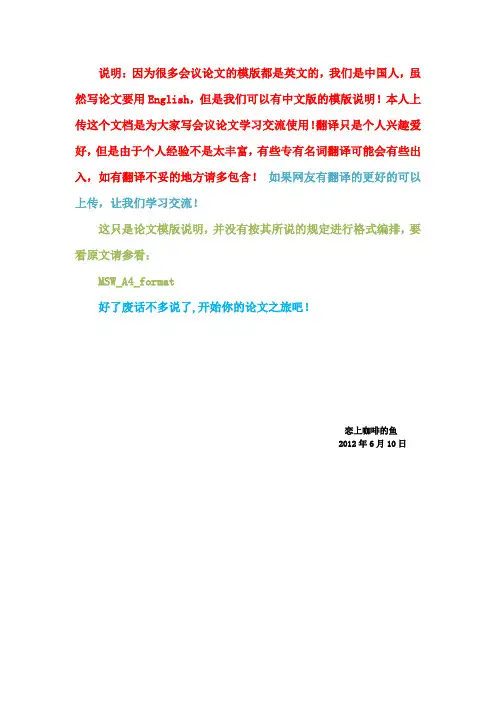
说明:因为很多会议论文的模版都是英文的,我们是中国人,虽然写论文要用English,但是我们可以有中文版的模版说明!本人上传这个文档是为大家写会议论文学习交流使用!翻译只是个人兴趣爱好,但是由于个人经验不是太丰富,有些专有名词翻译可能会有些出入,如有翻译不妥的地方请多包含!如果网友有翻译的更好的可以上传,让我们学习交流!这只是论文模版说明,并没有按其所说的规定进行格式编排,要看原文请参看:MSW_A4_format好了废话不多说了,开始你的论文之旅吧!恋上咖啡的鱼 2012年6月10日论文题目(使用样式:论文题目)副标题根据需要(论文副标题)第一从属作者姓名第二从属作者姓名第一行(从属关系):部门.组织机构名称第一行(从属关系):部门.组织机构名称第二行:组织机构名称,可以接受首字母缩写第二行:组织机构名称,可以接受首字母缩写第三行:城市,国家第三行:城市,国家第四行:电子邮箱如需要的话第四行:电子邮箱如需要的话摘要—这个电子文件是“排好版的”模版。
你论文的各种不同的组成部分[论文标题,正文,段落标题等]已经在这样式表中定义了,如文件中部分给出的举例说明。
(摘要)关键词-组件;格式化;类型;式样;插入(关键词)1.介绍(标题1)这个模版,对于个人电脑在MS Word 2003中修改以及保存为“Word 97-2003&6.0/95-RTF”,为作者提供了大部分他们论文需要准备的电子版本的格式规范。
所有标准论文组件被指定因为三个原因:(1)当格式化个人的论文时操作简单,(2)自动符合电子需求,以促进并发或后续生产的电子产品,(3)会议论文集从头到尾风格一致。
页边距,列宽度,行间距和字样是内置的;在文件中提供了字样的示例以及用斜体字类型辨识出,在圆括号中,在示例的后面。
一些组件,例如多层次公式,图形和表格没有指定,尽管提供了各种表文本样式。
格式化程序将需要创建这些组件,包含了适用的后续标准。
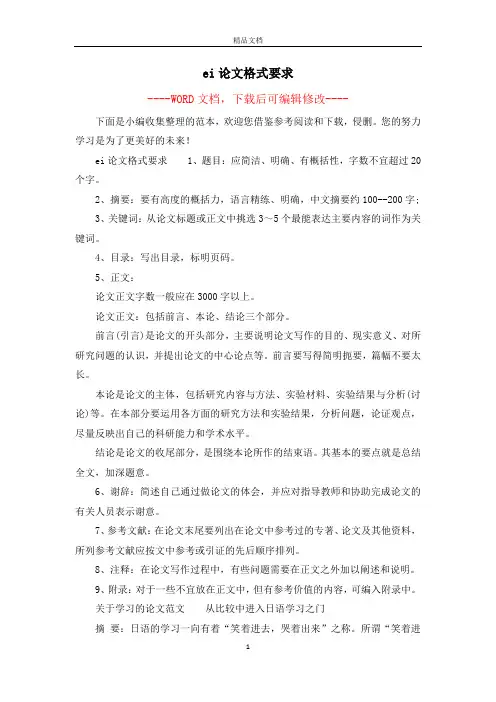
ei论文格式要求----WORD文档,下载后可编辑修改----下面是小编收集整理的范本,欢迎您借鉴参考阅读和下载,侵删。
您的努力学习是为了更美好的未来!ei论文格式要求1、题目:应简洁、明确、有概括性,字数不宜超过20个字。
2、摘要:要有高度的概括力,语言精练、明确,中文摘要约100--200字;3、关键词:从论文标题或正文中挑选3~5个最能表达主要内容的词作为关键词。
4、目录:写出目录,标明页码。
5、正文:论文正文字数一般应在3000字以上。
论文正文:包括前言、本论、结论三个部分。
前言(引言)是论文的开头部分,主要说明论文写作的目的、现实意义、对所研究问题的认识,并提出论文的中心论点等。
前言要写得简明扼要,篇幅不要太长。
本论是论文的主体,包括研究内容与方法、实验材料、实验结果与分析(讨论)等。
在本部分要运用各方面的研究方法和实验结果,分析问题,论证观点,尽量反映出自己的科研能力和学术水平。
结论是论文的收尾部分,是围绕本论所作的结束语。
其基本的要点就是总结全文,加深题意。
6、谢辞:简述自己通过做论文的体会,并应对指导教师和协助完成论文的有关人员表示谢意。
7、参考文献:在论文末尾要列出在论文中参考过的专著、论文及其他资料,所列参考文献应按文中参考或引证的先后顺序排列。
8、注释:在论文写作过程中,有些问题需要在正文之外加以阐述和说明。
9、附录:对于一些不宜放在正文中,但有参考价值的内容,可编入附录中。
关于学习的论文范文从比较中进入日语学习之门摘要:日语的学习一向有着“笑着进去,哭着出来”之称。
所谓“笑着进去”,大概是说为入门容易。
中日一衣带水,从古至今就有着千丝万缕的联系,现代日语汉字主要由汉字、假名、罗马字组成;日语的语音仿效了我国的汉音、唐音和吴音;日语的平假名、片假名借助了我国汉字或汉字的一部分,平假名形似中国书法艺术中的草书,片假名形似汉字中的偏旁,如同平假名中的あ(读a),便是从汉字草书中的“安”演化而来;日语的词汇大约一半是汉语词汇。
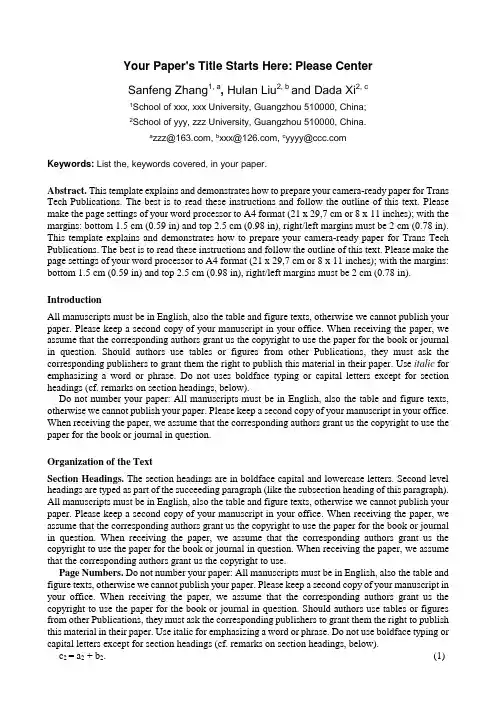
Your Paper's Title Starts Here: Please CenterSanfeng Zhang1, a, Hulan Liu2, b and Dada Xi2, c1School of xxx, xxx University, Guangzhou 510000, China;2School of yyy, zzz University, Guangzhou 510000, China.a zzz@,b xxx@,c yyyy@Keywords: List the, keywords covered, in your paper.Abstract. This template explains and demonstrates how to prepare your camera-ready paper for Trans Tech Publications. The best is to read these instructions and follow the outline of this text. Please make the page settings of your word processor to A4 format (21 x 29,7 cm or 8 x 11 inches); with the margins: bottom 1.5 cm (0.59 in) and top 2.5 cm (0.98 in), right/left margins must be 2 cm (0.78 in). This template explains and demonstrates how to prepare your camera-ready paper for Trans Tech Publications. The best is to read these instructions and follow the outline of this text. Please make the page settings of your word processor to A4 format (21 x 29,7 cm or 8 x 11 inches); with the margins: bottom 1.5 cm (0.59 in) and top 2.5 cm (0.98 in), right/left margins must be 2 cm (0.78 in). IntroductionAll manuscripts must be in English, also the table and figure texts, otherwise we cannot publish your paper. Please keep a second copy of your manuscript in your office. When receiving the paper, we assume that the corresponding authors grant us the copyright to use the paper for the book or journal in question. Should authors use tables or figures from other Publications, they must ask the corresponding publishers to grant them the right to publish this material in their paper. Use italic for emphasizing a word or phrase. Do not uses boldface typing or capital letters except for section headings (cf. remarks on section headings, below).Do not number your paper: All manuscripts must be in English, also the table and figure texts, otherwise we cannot publish your paper. Please keep a second copy of your manuscript in your office. When receiving the paper, we assume that the corresponding authors grant us the copyright to use the paper for the book or journal in question.Organization of the TextSection Headings. The section headings are in boldface capital and lowercase letters. Second level headings are typed as part of the succeeding paragraph (like the subsection heading of this paragraph). All manuscripts must be in English, also the table and figure texts, otherwise we cannot publish your paper. Please keep a second copy of your manuscript in your office. When receiving the paper, we assume that the corresponding authors grant us the copyright to use the paper for the book or journal in question. When receiving the paper, we assume that the corresponding authors grant us the copyright to use the paper for the book or journal in question. When receiving the paper, we assume that the corresponding authors grant us the copyright to use.Page Numbers. Do not number your paper: All manuscripts must be in English, also the table and figure texts, otherwise we cannot publish your paper. Please keep a second copy of your manuscript in your office. When receiving the paper, we assume that the corresponding authors grant us the copyright to use the paper for the book or journal in question. Should authors use tables or figures from other Publications, they must ask the corresponding publishers to grant them the right to publish this material in their paper. Use italic for emphasizing a word or phrase. Do not use boldface typing or capital letters except for section headings (cf. remarks on section headings, below).c2 = a2 + b2. (1)Literature ReferencesReferences are cited in the text just by square brackets [1]. (If square brackets are not available, slashes may be used instead, e.g. /2/.) Two or more references at a time may be put in one set of brackets [3, 4]. The references are to be numbered in the order in which they are cited in the text and are to be listed at the end of the contribution under a heading References, see our example below.Fig. 1 Two or more referencesReferences are cited in the text just by square brackets [1]. (If square brackets are not available, slashes may be used instead, e.g. /2/.) Two or more references at a time may be put in one set of brackets [3, 4]. The references are to be numbered in the order in which they are cited in the text and are to be listed at the end of the contribution under a heading References, see our example below.Table 1 Three Scheme comparingNumble Scheme 1 Scheme 2 Scheme 31 456 456 1232 789 213 6443 213 654 649SummaryIf you follow the “c hecklist”your paper will conform to the requirements of the publisher and facilitate a problem-free publication process.References[1] J. van der Geer, J.A.J. Hanraads, R.A. Lupton, The art of writing a scientific article, J. Sci. Commun. 163 (2000) 51-59.Reference to a book:[2] W. Strunk Jr., E.B. White, The Elements of Style, third ed., Macmillan, New York, 1979. Reference to a chapter in an edited book:[3] G.R. Mettam, L.B. Adams, How to prepare an electronic version of your article, in: B.S. Jones, R.Z. Smith (Eds.), Introduction to the Electronic Age, E-Publishing Inc., New York, 1999, pp. 281-304.[4] R.J. Ong, J.T. Dawley and P.G. Clem: submitted to Journal of Materials Research (2003)[5] P.G. Clem, M. Rodriguez, J.A. Voigt and C.S. Ashley, U.S. Patent 6,231,666. (2001)[6] Information on 参考文献说明(a) 期刊类:(作者: 刊名, 卷 (年) No.期号, p.起始页码.),刊名的所有实词首字母大写。
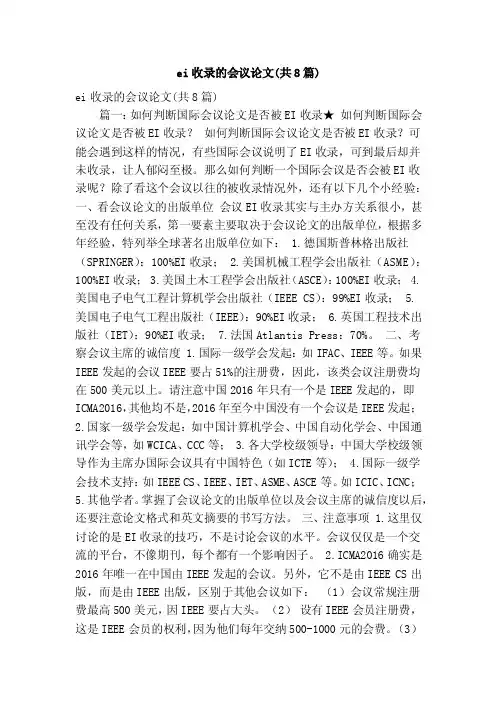
ei收录的会议论文(共8篇)ei收录的会议论文(共8篇)篇一:如何判断国际会议论文是否被EI收录★ 如何判断国际会议论文是否被EI收录?如何判断国际会议论文是否被EI收录?可能会遇到这样的情况,有些国际会议说明了EI收录,可到最后却并未收录,让人郁闷至极。
那么如何判断一个国际会议是否会被EI收录呢?除了看这个会议以往的被收录情况外,还有以下几个小经验:一、看会议论文的出版单位会议EI收录其实与主办方关系很小,甚至没有任何关系,第一要素主要取决于会议论文的出版单位,根据多年经验,特列举全球著名出版单位如下: 1.德国斯普林格出版社(SPRINGER):100%EI收录; 2.美国机械工程学会出版社(ASME):100%EI收录; 3.美国土木工程学会出版社(ASCE):100%EI收录; 4.美国电子电气工程计算机学会出版社(IEEE CS):99%EI收录; 5.美国电子电气工程出版社(IEEE):90%EI收录; 6.英国工程技术出版社(IET):90%EI收录; 7.法国Atlantis Press:70%。
二、考察会议主席的诚信度 1.国际一级学会发起:如IFAC、IEEE等。
如果IEEE发起的会议IEEE要占51%的注册费,因此,该类会议注册费均在500美元以上。
请注意中国2016年只有一个是IEEE发起的,即ICMA2016,其他均不是,2016年至今中国没有一个会议是IEEE发起;2.国家一级学会发起:如中国计算机学会、中国自动化学会、中国通讯学会等,如WCICA、CCC等;3.各大学校级领导:中国大学校级领导作为主席办国际会议具有中国特色(如ICTE等);4.国际一级学会技术支持:如IEEE CS、IEEE、IET、ASME、ASCE等。
如ICIC、ICNC;5.其他学者。
掌握了会议论文的出版单位以及会议主席的诚信度以后,还要注意论文格式和英文摘要的书写方法。
三、注意事项 1.这里仅讨论的是EI收录的技巧,不是讨论会议的水平。
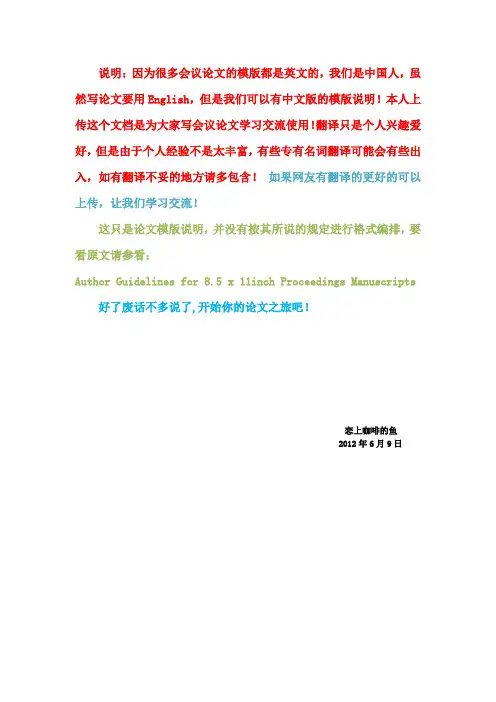
说明:因为很多会议论文的模版都是英文的,我们是中国人,虽然写论文要用English,但是我们可以有中文版的模版说明!本人上传这个文档是为大家写会议论文学习交流使用!翻译只是个人兴趣爱好,但是由于个人经验不是太丰富,有些专有名词翻译可能会有些出入,如有翻译不妥的地方请多包含!如果网友有翻译的更好的可以上传,让我们学习交流!这只是论文模版说明,并没有按其所说的规定进行格式编排,要看原文请参看:Author Guidelines for 8.5 x 11inch Proceedings Manuscripts 好了废话不多说了,开始你的论文之旅吧!恋上咖啡的鱼 2012年6月9日8.5 x 11英寸会议论文集手稿作者指南作者名字作者单位电子邮箱摘要摘要是两端对齐的斜体文本,位于左列的顶端,作者信息的下方。
使用单词“摘要”作为标题,12号Times字体,粗体字格式,相对于左列居中,首字母大写。
摘要内容格式为10号字体,单倍间距,长度不超过150个单词。
在摘要之后留出两空白行,然后开始正文书写。
1.介绍所有的原稿必须要用英语。
这些指南包括完整的字体、间隔和相关信息的描述来产生你的会议论文集手稿。
请遵循这些指南,如果你有任何的疑问,直接与负责你会议论文集的IEEE计算机协会出版社制作编辑联系:电话(714)821-8380或传真(714)761-1784。
2.你的论文排版所有印刷材料,包括文本,说明和图表必须保持在6-1/2英寸(16.51厘米)宽8-7/8英寸(22.51厘米)高的打印区域。
不要在打印区域之外书写或打印任何东西。
所有正文必须是两列的格式。
每列为3-1/16英寸(7.85厘米)宽,它们之间的间隔为3/8英寸(0.81厘米)。
正文必须两端对齐。
如Word和PDF文件<format.doc> and <format.pdf>,带有页边距和布局指南的格式页是可利用的。
它包含线条和框显示页边距和打印区域。
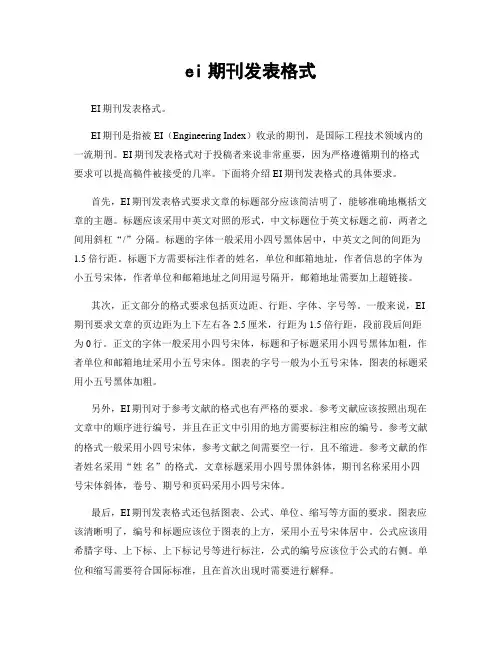
ei期刊发表格式EI期刊发表格式。
EI期刊是指被EI(Engineering Index)收录的期刊,是国际工程技术领域内的一流期刊。
EI期刊发表格式对于投稿者来说非常重要,因为严格遵循期刊的格式要求可以提高稿件被接受的几率。
下面将介绍EI期刊发表格式的具体要求。
首先,EI期刊发表格式要求文章的标题部分应该简洁明了,能够准确地概括文章的主题。
标题应该采用中英文对照的形式,中文标题位于英文标题之前,两者之间用斜杠“/”分隔。
标题的字体一般采用小四号黑体居中,中英文之间的间距为1.5倍行距。
标题下方需要标注作者的姓名,单位和邮箱地址,作者信息的字体为小五号宋体,作者单位和邮箱地址之间用逗号隔开,邮箱地址需要加上超链接。
其次,正文部分的格式要求包括页边距、行距、字体、字号等。
一般来说,EI 期刊要求文章的页边距为上下左右各2.5厘米,行距为1.5倍行距,段前段后间距为0行。
正文的字体一般采用小四号宋体,标题和子标题采用小四号黑体加粗,作者单位和邮箱地址采用小五号宋体。
图表的字号一般为小五号宋体,图表的标题采用小五号黑体加粗。
另外,EI期刊对于参考文献的格式也有严格的要求。
参考文献应该按照出现在文章中的顺序进行编号,并且在正文中引用的地方需要标注相应的编号。
参考文献的格式一般采用小四号宋体,参考文献之间需要空一行,且不缩进。
参考文献的作者姓名采用“姓名”的格式,文章标题采用小四号黑体斜体,期刊名称采用小四号宋体斜体,卷号、期号和页码采用小四号宋体。
最后,EI期刊发表格式还包括图表、公式、单位、缩写等方面的要求。
图表应该清晰明了,编号和标题应该位于图表的上方,采用小五号宋体居中。
公式应该用希腊字母、上下标、上下标记号等进行标注,公式的编号应该位于公式的右侧。
单位和缩写需要符合国际标准,且在首次出现时需要进行解释。
综上所述,EI期刊发表格式对于投稿者来说是非常重要的,严格遵循期刊的格式要求可以提高稿件被接受的几率。
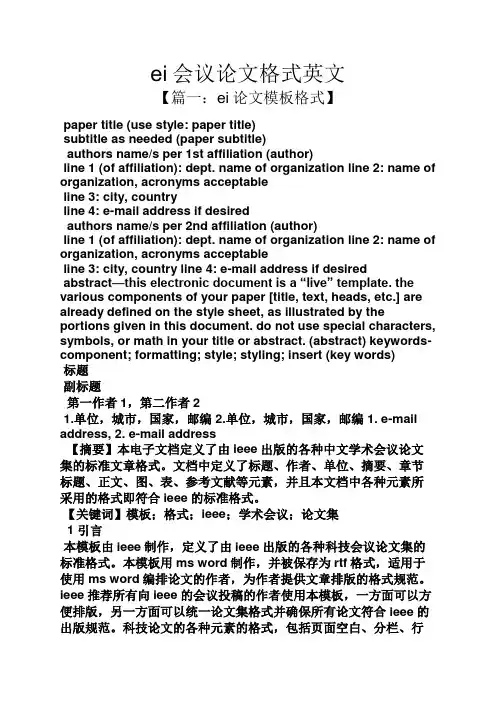
ei会议论文格式英文【篇一:ei论文模板格式】paper title (use style: paper title)subtitle as needed (paper subtitle)authors name/s per 1st affiliation (author)line 1 (of affiliation): dept. name of organization line 2: name of organization, acronyms acceptableline 3: city, countryline 4: e-mail address if desiredauthors name/s per 2nd affiliation (author)line 1 (of affiliation): dept. name of organization line 2: name of organization, acronyms acceptableline 3: city, country line 4: e-mail address if desiredabstract—this electronic document is a “live” template. the various components of your paper [title, text, heads, etc.] are already defined on the style sheet, as illustrated by the portions given in this document. do not use special characters, symbols, or math in your title or abstract. (abstract) keywords-component; formatting; style; styling; insert (key words)标题副标题第一作者1,第二作者21.单位,城市,国家,邮编2.单位,城市,国家,邮编 1. e-mail address, 2. e-mail address【摘要】本电子文档定义了由ieee出版的各种中文学术会议论文集的标准文章格式。
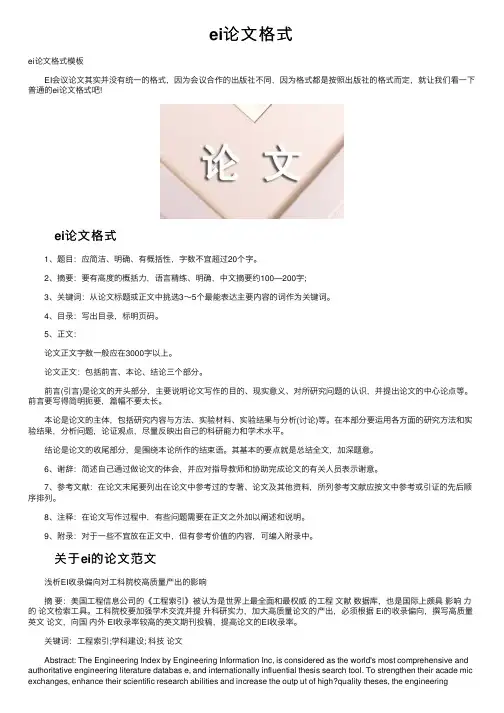
ei论⽂格式ei论⽂格式模板 EI会议论⽂其实并没有统⼀的格式,因为会议合作的出版社不同,因为格式都是按照出版社的格式⽽定,就让我们看⼀下普通的ei论⽂格式吧! ei论⽂格式 1、题⽬:应简洁、明确、有概括性,字数不宜超过20个字。
2、摘要:要有⾼度的概括⼒,语⾔精练、明确,中⽂摘要约100—200字; 3、关键词:从论⽂标题或正⽂中挑选3~5个最能表达主要内容的词作为关键词。
4、⽬录:写出⽬录,标明页码。
5、正⽂: 论⽂正⽂字数⼀般应在3000字以上。
论⽂正⽂:包括前⾔、本论、结论三个部分。
前⾔(引⾔)是论⽂的开头部分,主要说明论⽂写作的⽬的、现实意义、对所研究问题的认识,并提出论⽂的中⼼论点等。
前⾔要写得简明扼要,篇幅不要太长。
本论是论⽂的主体,包括研究内容与⽅法、实验材料、实验结果与分析(讨论)等。
在本部分要运⽤各⽅⾯的研究⽅法和实验结果,分析问题,论证观点,尽量反映出⾃⼰的科研能⼒和学术⽔平。
结论是论⽂的收尾部分,是围绕本论所作的结束语。
其基本的要点就是总结全⽂,加深题意。
6、谢辞:简述⾃⼰通过做论⽂的体会,并应对指导教师和协助完成论⽂的有关⼈员表⽰谢意。
7、参考⽂献:在论⽂末尾要列出在论⽂中参考过的专著、论⽂及其他资料,所列参考⽂献应按⽂中参考或引证的先后顺序排列。
8、注释:在论⽂写作过程中,有些问题需要在正⽂之外加以阐述和说明。
9、附录:对于⼀些不宜放在正⽂中,但有参考价值的内容,可编⼊附录中。
关于ei的论⽂范⽂ 浅析EI收录偏向对⼯科院校⾼质量产出的影响 摘要:美国⼯程信息公司的《⼯程索引》被认为是世界上最全⾯和最权威的⼯程⽂献数据库,也是国际上颇具影响⼒的论⽂检索⼯具。
⼯科院校要加强学术交流并提升科研实⼒,加⼤⾼质量论⽂的产出,必须根据 Ei的收录偏向,撰写⾼质量英⽂论⽂,向国内外 EI收录率较⾼的英⽂期刊投稿,提⾼论⽂的EI收录率。
关键词:⼯程索引;学科建设; 科技论⽂ Abstract: The Engineering Index by Engineering Information Inc, is considered as the world's most comprehensive and authoritative engineering literature databas e, and internationally influential thesis search tool. To strengthen their acade mic exchanges, enhance their scientific research abilities and increase the outp ut of high?quality theses, the engineeringcolleges and universities must, base d on the EI taste, produce high?quality theses in English and contribute them to English periodicals with high index rate at home and abroad, so that the ir thesis index rate can be increased. Key words:EI; subject building; science and technology these s 美国⼯程信息公司的《⼯程索引》(EI)被认为是世界上最全⾯和最权威的⼯程⽂献数据库,也是国际上颇具影响⼒的论⽂检索⼯具[1]。
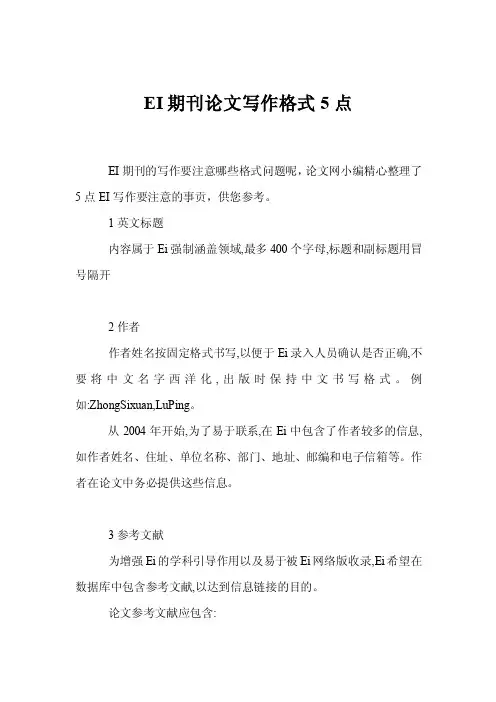
EI期刊论文写作格式5点EI期刊的写作要注意哪些格式问题呢,论文网小编精心整理了5点EI写作要注意的事贡,供您参考。
1英文标题内容属于Ei强制涵盖领域,最多400个字母,标题和副标题用冒号隔开2作者作者姓名按固定格式书写,以便于Ei录入人员确认是否正确,不要将中文名字西洋化,出版时保持中文书写格式。
例如:ZhongSixuan,LuPing。
从2004年开始,为了易于联系,在Ei中包含了作者较多的信息,如作者姓名、住址、单位名称、部门、地址、邮编和电子信箱等。
作者在论文中务必提供这些信息。
3参考文献为增强Ei的学科引导作用以及易于被Ei网络版收录,Ei希望在数据库中包含参考文献,以达到信息链接的目的。
论文参考文献应包含:(1)参考文献作者;(2)英文题名;(3)出版物(期刊、会刊或学报)的全部或缩略名称;(4)年、卷、期号和页码范围;(5)如果参考文献中出现网站名,则按原文列出,例如:CornellUniversityWebPage;如果参考文献是从网上获取的,不仅要给出确切网址,例如:http:/ionxsec,还应给出出版者名称、卷、期号、页码范围、出版时间。
WWW.LUNWENWANG.COM4关键词Ei使用的词库包含9000个术语,为了方便在线检索,Ei建议作者从这个检索收录词库中选择词或短语作为关键词。
关键词应包括代表论文内容的单词,例如一篇关于南京油田的论文,需用南京油田作为关键词。
5摘要摘要分信息性摘要(InformativeAbstract)和指示性摘要(IndicativeAbstract)两种类型。
前者包括研究的目的、方法、结果和结论;后者只对论文主要内容进行指示性报道,不报道方法和结论。
许多论文如会议论文、研究报道及期刊论文等的摘要都必须为信息性摘要,包含工作涉及的学科和领域、使用的方法、取得的结果和结论。
综述和评论性论文的摘要为指示性的,只描述工作的学科和领域即可,但为了进行详细描述,也可写成信息性摘要,它描述工作的学科和领域,还包括研究结果。
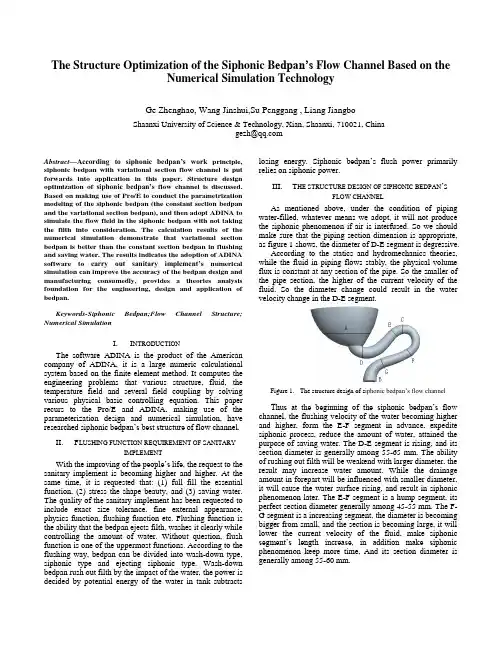
The Structure Optimization of the Siphonic B edpan’s Flow Channel Based on theNumerical Simulation TechnologyGe Zhenghao, Wang Jinshui,Su Penggang , Liang JiangboShaanxi University of Science & Technology, Xian, Shaanxi, 710021, Chinagezh@Abstract—According to siphonic bedpan’s work principle, siphonic bedpan with variational section flow channel is put forwards into application in this paper. Structure design optimization of siphonic bedpan’s flow channel is discussed. Based on making use of Pro/E to conduct the parametrization modeling of the siphonic bedpan (the constant section bedpan and the variational section bedpan), and then adopt ADINA to simulate the flow field in the siphonic bedpan with not taking the filth into consideration. The calculation results of the numerical simulation demonstrate that variational section bedpan is better than the constant section bedpan in flushing and saving water. The results indicates the adoption of ADINA software to carry out sanitary implement’s numerical simulation can improve the accuracy of the bedpan design and manufacturing consumedly, provides a theories analysis foundation for the engineering, design and application of bedpan.Keywords-Siphonic Bedpan;Flow Channel Structure; Numerical SimulationI.I NTRODUCTIONThe software ADINA is the product of the American company of ADINA, it is a large numeric calculational system based on the finite element method. It computes the engineering problems that various structure, fluid, the temperature field and several field coupling by solving various physical basic controlling equation. This paper recurs to the Pro/E and ADINA, making use of the parameterization design and numerical simulation, have researched siphonic b edpan‟s best structure of flow channel.II.F LUSHING FUNCTION REQUIREMENT OF SANITARYIMPLEMENTWith the improving of the people‟s life, the request to the sanitary implement is becoming higher and higher. At the same time, it is requested that: (1) full fill the essential function, (2) stress the shape beauty, and (3) saving water. The quality of the sanitary implement has been requested to include exact size tolerance, fine external appearance, physics function, flushing function etc. Flushing function is the ability that the bedpan ejects filth, washes it clearly while controlling the amount of water. Without question, flush function is one of the uppermost functions. According to the flushing way, bedpan can be divided into wash-down type, siphonic type and ejecting siphonic type. Wash-down bedpan rush out filth by the impact of the water, the power is decided by potential energy of the water in tank subtracts losing energy. S iphonic bedpan‟s flush power primarily relies on siphonic power.III.T HE STRUCTURE DESIGN OF SIPHONIC BEDPAN‟SFLOW CHANNELAs mentioned above, under the condition of piping water-filled, whatever means we adopt, it will not produce the siphonic phenomenon if air is interfused. So we should make sure that the piping section dimension is appropriate, as figure 1 shows, the diameter of D-E segment is degressive.According to the statics and hydromechanics theories, while the fluid in piping flows stably, the physical volume flux is constant at any section of the pipe. So the smaller of the pipe section, the higher of the current velocity of the fluid. So the diameter change could result in the watervelocity change in the D-E segment.Figure 1. The structure design of s iphonic bedpan‟s flow channelThus at the beginning of the siphonic bedpan‟s flow channel, the flushing velocity of the water becoming higher and higher, form the E-F segment in advance, expedite siphonic process, reduce the amount of water, attained the purpose of saving water. The D-E segment is rising, and its section diameter is generally among 55-65 mm. The ability of rushing out filth will be weakend with larger diameter, the result may increase water amount. While the drainage amount in forepart will be influenced with smaller diameter, it will cause the water surface rising, and result in siphonic phenomenon later. The E-F segment is a hump segment, its perfect section diameter generally among 45-55 mm. The F-G segment is a increasing segment, the diameter is becoming bigger from small, and the section is becoming large, it will lower the current velocity of the fluid, make siphonic segment‟s length increase, in addition make siphonic phenomenon keep more time, And its section diameter is generally among 55-60 mm.IV. T HREE -DIMENSIONAL S TEADY N UMERICS IMULATION FOR FLOWING IN BEDPANBedpa n‟s geometrical modeling is the most complicated in sanitary implements, its CAD model include complicated surface and characteristics, these may result in many difficulties during the numeric simulation and influence the result. Considering the siphonic b edpan‟s whole flow channel as computing area, and the difficulty to set up the CAD model in ADINA, so this paper make use of Pro/E to conduct the parameterization model of the siphonic bedpan. The water warp is 200 mm high, and the pipe diameter in the largest section is 80 mm.Then the model is imported into ADINA8.3 through IGES data format. In ADINA, we still need to predigest the physics model before adding load and boundary conditions. Detailed information is as follows:Load: velocity (the water warp‟s entry velocity is 1.5 m/s),Pressure (Pressure in piping exit), and in addition,Special boundary condition is wall. The material is water, and its density is 1.0×103 kg/m3,viscosity is 1.003×10-3 kg/(m·s).In ADINA, tetrahedral grid is adopted, and the model is meshed according to appointed unit length being 2 mm to the sections with same diameter. To the constant section bedpan, total meshing grid node amount is 3378, meshing grid unit amount is 15497, and to the variational section bedpan, meshing grid node amount is 2968, meshing grid unit amount is 13818. Appointed time step is 100, constantmagnitude is 0.1 S, the calculation results are showed as the figure 2 and 3.Figure 2. Pressure distributing for the constant section bedpanFigure 3. Pressure distributing for the variational section bedpanComparing the above two calculation results and in regard to pressure and velocity, in the approximate sameposition, the variational section bedpan obviously excelled the constant section bedpan. To the constant section bedpan, the maximal pressure is 7.3 E+06(Pa), the upmost velocity is 42.32 m/s, the pipe‟s exit maximal pressure is -77583 Pa, to the variational section bedpan, the maximal pressure is 2.178E+08(Pa), the upmost velocity is 193.2 m/s, the pipe‟s exit maximal pressure is -227620 Pa. Analyzing siphonic bedpan‟s flow channel structure, because of the rising segment, hump segment and descending segment, rising segment diameter is becoming smaller, thus in the beginning of the D-E segment, the water velocity becoming more and more high, filled the hump segment in advance, siphonic process was occurred rapidly. So make the siphonic pressure increase consumedly, and enhance the siphonic power, attained the purpose of saving water.V.T HE VOF ANALYSIS ON SIPHONIC BEDPAN ‟SFLUSHING PROCESSA. The VOF MethodThe VOF (Volume of Fluid) method is defined such a volume fraction F, defining the value of the point having fluid as 1, the value of the point having no fluid as 0. Thus, in a mesh unit, the F average value represents the quota that fluid contained the unit. If the average value is 1, the mesh is filled with the fluid, if the average value is 0, then for empty mesh. If the value is between 0 and 1, the mesh is free surface mesh. So it has advantages of easy realization, small calculation quantity, high-precision etc, and can handle complex nonlinear problem such as free surface folding, free surface filling water etc. When the model involves flow theories of the two phases or multi-phase, it introduces the single fluid model to solve problem. Namely, in the water-air two phase flow field, water and air obey the same team momentum equation. In the computing area, each controlling volume is filling with water and air, and their volume fraction‟s addition sh ould be 1, namely,1w a a a +=Among above, …a‟ denotes the volume fraction, subscript …w‟ and …a‟ denote water and air respectively. Once the water and air‟s volume fractions are known, all their unknown quantity and characteristic parameter can be denoted by average volume fraction. Tracking the water-air interface can be solved by nether consecutive equation.w w a V a t∂+⨯∇=∂Thereinto, …V ‟ denotes velocity vector.B. Boundary conditionsThe material property and the boundary conditions are as follows: Gas phase is air, and its density is 1.293 kg/m3, viscosity is 1.7894×10-5 kg/(m·s). Liquid phase is water, its density is 1.0×103 kg/m3, viscosity is 1.003×10-3 kg/(m·s). The work pressure is 101325 Pa. Gravitational acceleration is -9.8 m/s2, work density choose the lighter phase‟s, to obviate water static pressure calculation in the lighter phase, it need to improve the precision of momentum balance calculation.C.The result for bedpan’s VOF analys isAccording to the above computing conditions, defininginitial condition is, water tank and water envelop are allfilled with water, and we can get the result of the bedpan‟sflushing process in 0-6s.1)Flushing procesThe figure 4 shows flowing field distributions at differentmoment.Figure 4. Distributing of flow at different moment by simulation for thevariational section bedpanIn the figures above, areas in red colour represent water,areas in navy blue represent air, other colours represent themixture of water and air. Contrasting the flow fielddistribution of the constant section bedpan to the variationalsection bedpan, we will found, to the constant sectionbedpan, during 0-5s, water caput hasn‟t gotten across thepipe‟s tiptop while to the variational section bedpan, watercaput has already gotten across during 0-1s and in 5.6 s,water in the warp has flowed out completely. This mainlybecause when the water caput got across the pipe‟s tiptop,the siphonic phenomenon happens. W ater warp‟s outflowincreases largely. This makes water level drop rapidly andreach lowest level in warp, and then the siphonicphenomenon stops, water velocity becomes lower, water thathas not gotten across the pipe‟s tiptop start to turn back, andfinally become level off.2)Pressure distributionThe figure 5 shows pressure distribution at differentmoment for the variational section bedpan. In the followingfigures, to the constant section bedpan, the minus pressure is-695.4 Pa, while to the variational section bedpan, the minuspressure is -1733 Pa, this difference shows the strongfunction of siphon.Figure 5. Pressure distributing at different moment for the variationalsection bedpan3) Velocity distributionAs the figure 6 shows, velocity for the variational section bedpan is averagely larger than the velocity for the constant section bedpan, consequently, it provide effective gist for variational section bedpan, it can easily achieve effectively flushing aim compared to the constant section bedpan. Besides, it indirectly indicates that the variational sectionbedpan can easily achieve the function of saving water.Figure 6. The velocity distribution of the two kind sections bedpan pipeVI. C ONCLUSIONSThis paper studied on the structure optimization of the s iphonic bedpan‟s flow channel, recurring to finite element software ADINA, three-dimensional steady flow numeric simulation of water flowing in bedpan is carried out, the VOF analysis on siphonic bedpan‟s flushing process has also been carried out. The results can help technics designers find out the disfigurement essentially, enhance the precision inthe porcelain sanitation field. Further more, it will shorten the exploiting time and expense of the new product consumedly, bring remarkable economic benefit to producing enterprise.A CKNOWLEDGMENTThe preferred spelling of the word “acknowledgment” in America is without an “e” after the “g”. Avoid the stilted expression, “One of us (R.B.G.) thanks . . .” Instead, try “R.B.G. thanks”. Put applicable sponsor acknowledgments here; DO NOT place them on the first page of your paper or as a footnote.R EFERENCES[1] Yue bangguo, “Talking about bedpan‟s flushing filth function andsaving water,” Chinaware, 2001(5).(in Chinese)[2] Wu ziniu, The basic elements of computing hydromechanics. Beijing:the Science Press. 2001. 1-8. (in Chinese)[3] Hong fangwen, “Kinetic object round free surface flowing field valuesimulation and experimentation research,” Doctor Degree thesis. Wuxi, Jiangsu, China: Chinese watercraft science research center. 2001.4. (in Chinese)[4] C.W. Hirt, B.D. Nichols. Volume of fluid (VOF) method for thedynamics of free boundaries. Journal of Computational Physics, 1981, 39:201-225.[5] Lin huzong, Phantasmagoric flowing science-multiphasehydromechanics. Beijing: the book concern of Qinghua University, Guangzhou: the book concern of Jinan University. (in Chinese)[6] Wang youcheng, Shao min, The theory and numeric method on finiteelement analysis. Beijing: the book concern of Qinghua University, 1997. (in Chinese)。
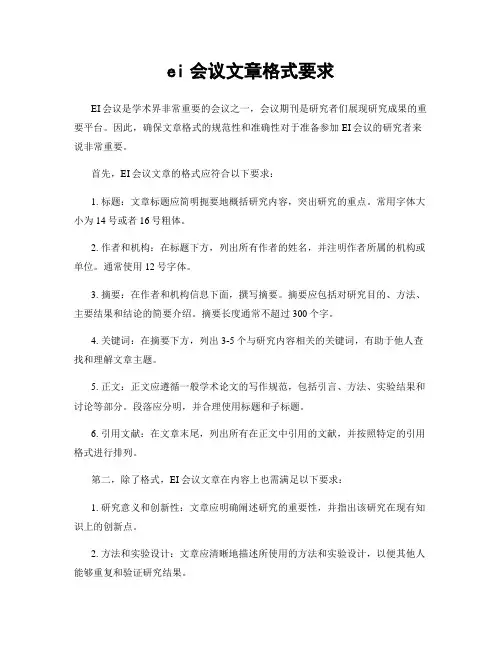
ei会议文章格式要求EI会议是学术界非常重要的会议之一,会议期刊是研究者们展现研究成果的重要平台。
因此,确保文章格式的规范性和准确性对于准备参加EI会议的研究者来说非常重要。
首先,EI会议文章的格式应符合以下要求:1. 标题:文章标题应简明扼要地概括研究内容,突出研究的重点。
常用字体大小为14号或者16号粗体。
2. 作者和机构:在标题下方,列出所有作者的姓名,并注明作者所属的机构或单位。
通常使用12号字体。
3. 摘要:在作者和机构信息下面,撰写摘要。
摘要应包括对研究目的、方法、主要结果和结论的简要介绍。
摘要长度通常不超过300个字。
4. 关键词:在摘要下方,列出3-5个与研究内容相关的关键词,有助于他人查找和理解文章主题。
5. 正文:正文应遵循一般学术论文的写作规范,包括引言、方法、实验结果和讨论等部分。
段落应分明,并合理使用标题和子标题。
6. 引用文献:在文章末尾,列出所有在正文中引用的文献,并按照特定的引用格式进行排列。
第二,除了格式,EI会议文章在内容上也需满足以下要求:1. 研究意义和创新性:文章应明确阐述研究的重要性,并指出该研究在现有知识上的创新点。
2. 方法和实验设计:文章应清晰地描述所使用的方法和实验设计,以便其他人能够重复和验证研究结果。
3. 结果和分析:文章应准确地呈现实验结果,并对结果进行正确和客观的分析,以支持作者的结论。
4. 讨论和结论:文章应对结果进行进一步的讨论,阐明研究的局限和未来的研究方向,并给出结论。
最后,使用正确的语言和规范的学术文体也是文章写作过程中的重要考虑因素。
避免使用口语化的表达,确保文章的准确性和专业性。
总结来说,为了满足EI会议的文章格式要求,作者们需要确保文章格式规范,内容准确,同时遵循学术写作的要求和规范。
这将有助于增加文章的可读性和引用率,提高研究成果的影响力。
ei会议论文格式有很多网友都在为ei会议论文的格式发愁,下面是小编为大家精心推荐的ei会议论文格式,希望能够对您有所帮助。
ei会议论文格式1. 提供完整对应的中英文对照不言而喻,Ei数据库在处理数据时使用的语言为英语。
因此,应确保出现在中文摘要的全部作者的姓名、单位及顺序号、城市及邮编、电子信箱(非必要)、身份头衔等在英文中得到对应反映。
不可用et al 代替后面几位,以避免遗漏,损害著作者权益。
2. 明确姓氏与名字的定位作者为外族或外国人士时(尤其是中东、日本和朝鲜等国),最好用完全大写姓氏表示姓氏,首字母大写表示名字。
或按照汉语姓名排列,做到全刊的姓名顺序一致,以避免可能出现的混淆和误解。
3. 准确标示Email所属Ei数据库自2004年起规定:Email中若含有姓名字母,其使用者应为本人。
Emai位置排列应使读者明白其对应的作者是谁。
4. 明确标示特定联系人通常,第一作者即为联系人,这种情况下,可不作任何标记,否则应以文字或符号指明特定联系人。
任何象征性的,或在作者和编者看来不言而喻的说明,都不足以表明联系人身份。
5. 明确标示作者和单位的对应关系作者和单位的关系要使读者一目了然。
另外,即使是第二,第三作者单位也要给出英文单位。
6. 相同单位应译法相同不要出现同一作者单位不同的写法,有的甚至在同一本刊中同一单位就有两种写法。
7. 完整译出单位名称作者单位既是与作者通讯联系的重要途径,也是保证作者资格得到承认的必要参考。
因此,除确属保密性质或全球知名的企事业单位外,单位名称请不要使用几个大写字母所组成的完全缩写或简称。
同时,鉴于某些词汇的缩写有所不同,也请不要自行缩写个别单词,以减少出错的可能。
8. 按照英文习惯排列单位内部级别顺序请按照英文习惯从小到大排列一个单位的内部各级。
此外,当单位为教育部某一实验室时,一般不可以只标出“实验室”和“教育部”两个单位,而应标明所在大学或科研机构。
三、关键词1.尽量不要省去关键词或以分类码代替词。
怎样发表SCI、EI论文?一、基本要求:必须满足国际检索系统对论文格式的要求,至少应包括下列几项(英文):1、论文题名题名应简明、确切,不要太长、太笼统。
英文题名可以省去定冠词和不定冠词如the、a、an 等。
题名内不应列入非公知公用的符号、代号,以及数学公式、化学结构式等。
2、作者姓名的汉语拼音应按GB/T 16159-1996《汉语拼音正词法基本规则》拼写。
作者姓氏在前,全大写。
名字在后,首字母大写;双名连写,其间加半字线。
注意:不要将姓氏写在名字后;也不要将名字缩写;如是多位作者,姓名之间用逗号隔开。
3、工作单位工作单位要规范、统一、稳定,英文译名结尾处应加"China"。
如:华南理工大学化学工程研究所,广东广州510640(Institute of Chemical Engineering,South China University of Technology Guangzhou 510640, China)4、多作者、多工作单位,应写成LI Zhi-gang1, CHEN Xiang-dong1, WANG Ping 2, ZHANG YU-shun3 (1. State Key Lab. of Struct. Anal. of Ind. Equip., Dalian Univ. of Technol. ,Dalian 116024, China;2.Inst. of Eng. Mech. of State Earthq. Bureau, Harbin 150080, China; 3. Inst. of Earthq. of Guangdong Prov., Guangzhou 510070,China)5、英文摘要国际重要检索系统通常采用英语。
它们在收录一篇论文摘要时,主要是看英文摘。
所以英文摘要编写的质量是非常关键的。
它包括:摘要内容、格式、语句的时态和用词的准确性。
ei会议论文(共3篇)ei会议论文(共3篇)篇一:EI会议论文EI会议论文四大检索系统 SCI、EI、ISTP、ISR是世界四大重要检索系统,其收录文章的状况是评价国家、单位和科研人员的成绩、水平以及进行奖励的重要依据之一。
我国被四大系统收录的论文数量逐年增长。
学校在”1512工程”建设及科技成果奖励方案中均十分重视四大系统,也已成为教师和科研人员提升自己的努力方向。
何为EI 3千到8千元不等。
一般用作:硕士毕业、博士毕业、评副教授、评正教授使用。
作者在国际会议或者国际杂志上发表论文被EI收录后,国内一些权威机构可以出具EI收录证书给作者。
EI类型现在EI数据库的收录的文献只分为两类:会议检索与期刊检索,其判断如下: A 会议论文:Conference article一般来说,期刊论文的质量略高于会议论文。
EI会议与核心的比较A.横向比较(数量级):一篇EI检索论文,约等于中国国内的核心期刊3-5篇。
B.纵向比较(质量级):ISTP,属于国际级出版物;核心期刊属于国家级出版物。
C.立体比较(实效性):高级职称晋升要求本专业相关刊物上公开发表教学、科研论文5篇,其中被SCI、ISTP、EI收录全文收录3篇以上,并撰写15万字以上公开出版发行的专著或教材。
EI会议发表途径金笔杆中心能够帮助解决这个困惑,。
录用时间快,文章质量高,保证入库。
篇二:EI学术论文检索、EI会议论文核心检索入口EI论文检索入口华译网论文翻译专业机构汇集EI检索地址如下,本文后附有华译网EI 论文翻译价格和英文论文外籍校对价格,欢迎大家惠顾。
EI论文检索入口常用网址如下:英特网EI官方网址:/Kns55/brief/Result_CPFD.htm 清华大学图书馆:/service/SCIcenter/eiall.html 《工程索引》(The Engineering Index,简称EI)是美国工程信息公司(Engineering information Inc.)出版的著名工程技术类综合性检索工具。
ei会议参考文献格式
EI会议参考文献格式是学术会议中一种常用的格式,具体格式要求如下:
1. 首先是作者姓名和单位,在作者名与单位之间用逗号分隔。
如果有多个作者,用“,”分隔,最后一个作者之后使用“and”分隔。
作者和单位之间用分号分隔,最后一个作者的单位之前不用分号。
2. 接下来是文章的标题,第一字母大写,不加引号。
3. 然后是会议名称和会议日期,会议名称用斜体字书写,会议
日期用阿拉伯数字表示,并用圆括号括起来。
4. 紧接着是出版地点和出版者,用冒号隔开。
5. 最后是页码,用“pp.”标记。
具体参考文献格式如下:
1. 期刊论文
[1] 作者1, 作者2, …, and 作者n. 文章标题[J]. 期刊名称, 年份, 卷号(期号): 页码.
2. 会议论文
[2] 作者1, 作者2, …, and 作者n. 文章标题. In: 会议名称, 会议日期, 地点. 出版地点: 出版者, 年份. pp. 页码.
3. 学位论文
[3] 作者姓名. 论文题目[D]. 出版地点: 出版者, 年份.
4. 书籍
[4] 作者姓名. 书名[M]. 出版地点: 出版者, 年份.
总体而言,EI会议参考文献格式要求简明扼要,重点在于突出作者、文章标题及会议日期等信息。
人们只有按照标准格式编写文献,
才可以方便地进行文献检索、引用和查询,以提高学术研究的效率。
Paper Title Subtitle as neededAuthors Name/s per 1st Affiliation (Author) line 1 (of Affiliation): dept. name of organization line 2: name of organization, acronyms acceptableline 3: City, Countryline 4: e-mail: name@ Authors Name/s per 2nd Affiliation (Author) line 1 (of Affiliation): dept. name of organization line 2: name of organization, acronyms acceptableline 3: City, Countryline 4: e-mail: name@Abstract—This electronic document is a “live” template. The various components of your paper [title, text, heads, etc.] are already defined on the style sheet, as illustrated by the portions given in this document. DO NOT USE SPECIAL CHARACTERS, SYMBOLS, OR MATH IN YOUR TITLE OR ABSTRACT. (Abstract)Keywords-component; formatting; style; styling; insert (key words)I.I NTRODUCTION (H EADING 1)All manuscripts must be in English. These guidelines include complete descriptions of the fonts, spacing, and related information for producing your proceedings manuscripts. Please follow them and if you have any questions, direct them to the production editor in charge of your proceedings at Conference Publishing Services (CPS): Phone +1 (714) 821-8380 or Fax +1 (714) 761-1784.This template provides authors with most of the formatting specifications needed for preparing electronic versions of their papers. All standard paper components have been specified for three reasons: (1) ease of use when formatting individual papers, (2) automatic compliance to electronic requirements that facilitate the concurrent or later production of electronic products, and (3) conformity of style throughout a conference proceedings. Margins, column widths, line spacing, and type styles are built-in; examples of the type styles are provided throughout this document and are identified in italic type, within parentheses, following the example. PLEASE DO NOT RE-ADJUST THESE MARGINS. Some components, such as multi-leveled equations, graphics, and tables are not prescribed, although the various table text styles are provided. The formatter will need to create these components, incorporating the applicable criteria that follow.II.T YPE S TYLE AND F ONTSWherever Times is specified, Times Roman or Times New Roman may be used. If neither is available on your word processor, please use the font closest in appearance to Times. Avoid using bit-mapped fonts if possible. True-Type 1 or Open Type fonts are preferred. Please embed symbol fonts, as well, for math, etc.III.E ASE OF U SEA.Selecting a Template (Heading 2)First, confirm that you have the correct template for your paper size. This template has been tailored for output on the US-letter paper size. If you are using A4-sized paper, please close this template and download the file for A4 paper format called ―CPS_A4_format‖.B.Maintaining the Integrity of the SpecificationsThe template is used to format your paper and style the text. All margins, column widths, line spaces, and text fonts are prescribed; please do not alter them. You may note peculiarities. For example, the head margin in this template measures proportionately more than is customary. This measurement and others are deliberate, using specifications that anticipate your paper as one part of the entire proceedings, and not as an independent document. Please do not revise any of the current designations.IV.P REPARE Y OUR P APER B EFORE S TYLING Before you begin to format your paper, first write and save the content as a separate text file. Keep your text and graphic files separate until after the text has been formatted and styled. Do not use hard tabs, and limit use of hard returns to only one return at the end of a paragraph. Do not add any kind of pagination anywhere in the paper. Do not number text heads-the template will do that for you.Finally, complete content and organizational editing before formatting. Please take note of the following items when proofreading spelling and grammar:A.Abbreviations and AcronymsDefine abbreviations and acronyms the first time they are used in the text, even after they have been defined in the abstract. Abbreviations such as IEEE, SI, MKS, CGS, sc, dc, and rms do not have to be defined. Do not use abbreviations in the title or heads unless they are unavoidable.Identify applicable sponsor/s here. (sponsors)B.Units∙Use either SI (MKS) or CGS as primary units. (SI units are encouraged.) English units may be used assecondary units (in parentheses). An exceptionwould be the use of English units as identifiers intrade, such as ―3.5-inch disk drive‖.∙Avoid combining SI and CGS units, such as current in amperes and magnetic field in oersteds. This oftenleads to confusion because equations do not balancedimensionally. If you must use mixed units, clearlystate the units for each quantity that you use in anequation.∙Do not mix complete spellings and abbreviations of units: ―Wb/m2‖ or ―webers per square meter‖, not―webers/m2‖. Spell out units when they appear intext: ―. . . a few henries‖, not ―. . . a few H‖.∙Use a zero before dec imal points: ―0.25‖, not ―.25‖. C.EquationsThe equations are an exception to the prescribed specifications of this template. You will need to determine whether or not your equation should be typed using either the Times New Roman or the Symbol font (please no other font). To create multileveled equations, it may be necessary to treat the equation as a graphic and insert it into the text after your paper is styled.Number equations consecutively. Equation numbers, within parentheses, are to position flush right, as in (1), using a right tab stop. To make your equations more compact, you may use the solidus ( / ), the exp function, or appropriate exponents. Italicize Roman symbols for quantities and variables, but not Greek symbols. Use a long dash rather than a hyphen for a minus sign. Punctuate equations with commas or periods when they are part of a sentence, as inα + β = χ. (1)Note that the equation is centered using a center tab stop. Be sure that the symbols in your equation have been defined before or immediately following the equation. Use ―(1)‖, not ―Eq. (1)‖ or ―equation (1)‖, except at the beginning of a sentence: ―Equation (1) is . . .‖D.Some Common Mistakes∙The word ―data‖ is plural, not singular.∙The subscript for the permeability of vacuum μ0, and other common scientific constants, is zero withsubscript formatting, not a lowercase letter ―o‖.∙In American English, commas, semi-/colons, periods, question and exclamation marks are located withinquotation marks only when a complete thought orname is cited, such as a title or full quotation. Whenquotation marks are used, instead of a bold or italictypeface, to highlight a word or phrase, punctuationshould appear outside of the quotation marks. Aparenthetical phrase or statement at the end of asentence is punctuated outside of the closingparenthesis (like this). (A parenthetical sentence ispunctuated within the parentheses.)∙ A graph within a graph is an ―inset‖, not an ―insert‖.The word alternatively is preferred to the word―alternately‖ (unless you really mean something thatalternates).∙Do not use the word ―essentially‖ to mean ―approximately‖ or ―effectively‖.∙In your paper title, if the words ―that uses‖ can accurately replace the word ―using‖, capitalize the―u‖; if not, keep using lower-cased.∙Be aware of the different meanings of the homophones ―affect‖ and ―effect‖, ―complement‖and ―compliment‖, ―discreet‖ and ―discrete‖,―principal‖ and ―principle‖.∙Do not confuse ―imply‖ and ―infer‖.∙The prefix ―non‖ is not a word; it should be joined to the word it modifies, usually without a hyphen.∙There is no period after the ―et‖ in the Latin abbreviati on ―et al.‖.∙The abbreviation ―i.e.‖ means ―that is‖, and the abbreviation ―e.g.‖ means ―for example‖.An excellent style manual for science writers is [7].V.U SING THE T EMPLATEAfter the text edit has been completed, the paper is ready for the template. Duplicate the template file by using the Save As command, and use the naming convention prescribed by your conference for the name of your paper. In this newly created file, highlight all of the contents and import your prepared text file. You are now ready to style your paper.A.Authors and AffiliationsThe template is designed so that author affiliations are not repeated each time for multiple authors of the same affiliation. Please keep your affiliations as succinct as possible (for example, do not differentiate among departments of the same organization). This template was designed for two affiliations.1)For author/s of only one affiliation (Heading 3): To change the default, adjust the template as follows.a)Selection (Heading 4): Highlight all author and affiliation lines.b)Change number of columns: Select Format > Columns >Presets > One Column.c)Deletion: Delete the author and affiliation lines for the second affiliation.d)For author/s of more than two affiliations: To change the default, adjust the template as follows.e)Selection: Highlight all author and affiliation lines.f)Change number of columns: Select Format > Columns > Presets > One Column.g)Highlight author and affiliation lines of affiliation 1 and copy this selection.h)Formatting: Insert one hard return immediately after the last character of the last affiliation line. Then paste the copy of affiliation 1. Repeat as necessary for each additional affiliation.i)Reassign number of columns: Place your cursor to the right of the last character of the last affiliation line of an even numbered affiliation (e.g., if there are five affiliations, place your cursor at end of fourth affiliation). Drag the cursor up to highlight all of the above author and affiliation lines. Go to Format > Columns and select ―2 Columns‖. I f you have an odd number of affiliations, the final affiliation will be centered on the page; all previous will be in two columns.B.Identify the HeadingsHeadings, or heads, are organizational devices that guide the reader through your paper. There are two types: component heads and text heads.Component heads identify the different components of your paper and are not topically subordinate to each other. Examples include Acknowledgments and References and, for these, the correct style to use is ―Heading5‖. Use ―figurecaption‖ for your Figure captions, and ―table head‖ for your table title. Run-in heads, such as ―Abstract‖, will require you to apply a style (in this case, italic) in addition to the style provided by the drop down menu to differentiate the head from the text.Text heads organize the topics on a relational, hierarchical basis. For example, the paper title is the primary text head because all subsequent material relates and elaborates on this one topic. If there are two or more sub-topics, the next level head (uppercase Roman numerals) should be used and, conversely, if there are not at least two sub-topics, then no subheads should be introduced. Styles named ―Heading 1‖, ―Heading 2‖, ―Heading 3‖, and ―Heading 4‖ are prescribed.C.Figures and Tables1)Positioning Figures and Tables: Place figures and tables at the top and bottom of columns. Avoid placing them in the middle of columns. Large figures and tables may span across both columns. Figure captions should be below the figures; table heads should appear above the tables. Insert figures and tables after they are cited in the text. Use the abbreviation ―Fig. 1‖, even at the beginning of a sentence.TABLE I. T ABLE T YPE S TYLESa. Sample of a Table footnote. (Table footnote)Figure 1. Example of a ONE-COLUMN figure caption.Please see last page of this document for AN EXAMPLE of a 2-COLUMN Figure.Figure Labels: Use 8 point Times New Roman for Figure labels. Use words rather than symbols or abbreviations when writing Figure axis labels to avoid confusing the reader. As an example, write the quantity ―Magnetization‖, or―Magnetization, M‖, not just ―M‖. If including units in the label, present them within parentheses. Do not label axes only with units. In the example, write ―Magnetization (A/m)‖ or ―Magnetization {A[m(1)]}‖, not just ―A/m‖. Do not label axes with a ratio of quantities and units. For example, write ―Temperature (K)‖, not ―Temperature/K‖. D.FootnotesUse footnotes sparingly (or not at all) and place them at the bottom of the column on the page on which they are referenced. Use Times 8-point type, single-spaced. To help your readers, avoid using footnotes altogether and include necessary peripheral observations in the text (within parentheses, if you prefer, as in this sentence).VI.C OPYRIGHT F ORMS AND R EPRINT O RDERS You must submit the IEEE Electronic Copyright Form (ECF) per Step 7 of the CPS author kit’s web page. THIS FORM MUST BE SUBMITTED IN ORDER TO PUBLISH YOUR PAPER.Please see Step 9 for ordering reprints of your paper. Reprints may be ordered using the form provided as <reprint.doc> or <reprint.pdf>.A CKNOWLEDGMENTThe preferred spelling of the word ―acknowledgment‖ in America is without an ―e‖ after the ―g‖. Avoid the stilted expression, ―One of us (R.B.G.) thanks . . .‖ Instead, try ―R.B.G. thanks‖. Put applicable sponsor acknowledgments here; DO NOT place them on the first page of your paper or as a footnote.R EFERENCESList and number all bibliographical references in 9-point Times, single-spaced, at the end of your paper. When referenced in the text, enclose the citation number in square brackets, for example [1]. Where appropriate, include the name(s) of editors of referenced books. The template will number citations consecutively within brackets [1]. The sentence punctuation follows the bracket [2]. Refer simply to the reference number, as in [3]—do not use ―Ref. [3]‖ or ―reference [3]‖ except at the beginning of a sentence: ―Reference [3] was the first. . .‖Number footnotes separately in superscripts. Place the actual footnote at the bottom of the column in which it was cited. Do not put footnotes in the reference list. Use letters for table footnotes.Unless there are six authors or more give all authors’names; do not use ―et al.‖. Papers that have not been published, even if they have been submitted for publication,should be cited as ―unpublished‖ [4]. Papers that have been accepted for publication should be cited as ―in press‖ [5]. Capitalize only the first word in a paper title, except for proper nouns and element symbols.For papers published in translation journals, please give the English citation first, followed by the original foreign-language citation [6].[1]G. Eason, B. Noble, and I. N. Sned don, ―On certain integrals ofLipschitz-Hankel type involving products of Bessel functions,‖ Phil.Trans. Roy. Soc. London, vol. A247, pp. 529–551, April 1955.(references)[2]J. Clerk Maxwell, A Treatise on Electricity and Magnetism, 3rd ed.,vol. 2. Oxford: Clarendon, 1892, pp.68–73.[3]I. S. Jacobs and C. P. Bean, ―Fine particles, thin films and exchangeanisotropy,‖ in Magnetism, vol. III, G. T. Rado and H. Suhl, Eds.New York: Academic, 1963, pp. 271–350.[4]K. Elissa, ―Title of paper if known,‖ unpublished.[5]R. Nicole, ―Title of paper with only first word capitalized,‖ J. NameStand. Abbrev., in press.[6]Y. Yorozu, M. Hirano, K. Oka, and Y. Tagawa, ―Electronspectroscopy studies on magneto-optical media and plastic substrate interface,‖ IEEE Transl. J. Magn. Japan, vol. 2, pp. 740–741, August 1987 [Digests 9th Annual Conf. Magnetics Japan, p. 301, 1982]. [7]M. Young, The Technical Writer’s Handbook. Mill Valley, CA:University Science, 1989.[8]Electronic Publication: Digital Object Identifiers (DOIs):Article in a journal:[9] D. Kornack and P. Rakic, ―Cell Proliferation without Neurogenesis inAdult Primate Neocortex,‖ Science, vol. 294, Dec. 2001, pp. 2127-2130, doi:10.1126/science.1065467.Article in a conference proceedings:[10]H. Goto, Y. Hasegawa, and M. Tanaka, ―Efficien t SchedulingFocusing on the Duality of MPL Representatives,‖ Proc. IEEE Symp.Computational Intelligence in Scheduling (SCIS 07), IEEE Press, Dec.2007, pp. 57-64, doi:10.1109/SCIS.2007.357670.Figure 2. Example of a TWO-COLUMN figure caption: (a) this is the format for referencing parts of a figure.。
ei 论文格式两篇时光给了我们太多无奈,但不变的是对青春热爱的心。
.--UUMOB EI会议论文其实并没有统一的格式,因为会议合作的出版社不同,因为格式都是按照出版社的格式而定。
其实EI会议论文投稿前,不用花太多心思在格式上,只需要尽量关注文章质量即可,等文章录用了,会务组会再给您一次修改论文的机会,再调整格式不迟。
如果您需要EI会议论文格式,一般去您所投的会网站的“paper submmsioni”栏目会提供论文模板下载的。
下面提供各个常见出版社的论文格式压缩包,您需要先查看下会议合作的出版社,然后选择相应的论文格式模板。
常见EI会议论文出版社格式下载如果您是第一次按照会议模板调整格式,您会发现非常麻烦,尤其是对于word不熟悉的朋友,更是麻烦,这里教大家一个快速调整格式的方法,先下载相应的会议模板,然后把文章的题目、摘要直接以文本方式替换即可,然后把会议模板结构按照你论文的结构模仿一遍,然后直接将您论文的每个正文部分依次复制到官网模板里去即可。
这样可以很快保证格式与会议模板一模一样。
可能我这么说,当您实际去操作时,依然会碰到一些麻烦,但是一旦熟练了,这种办法是非常方便的,而且关键是由于直接拿会议模板,只是内容替换了,所以调整后的格式可以做到与模板格式要求一模一样,丝毫不差。
要想保证会议论文进EI的概率,必须要选择好权威的会议和出版社才行,其实严格意义上的100%进EI是不存在的,EI会议由于现在“鱼龙混杂”,很难识别其权威性,这里笔者教大家几个判断权威性的办法:1、看会议举办次数。
如果是举办了多次,那么就查查这个会议的历史检索记录,看下是不是近几年开的会议都进了EI。
如果是第一次举办,则没有任何历史记录,这也不意味着会议就一定不权威,您需要通过其它指标判断。
2、看会议出版社。
如果是TTP旗下的AMM和AMR,估计不行了,因为这两个期刊已经不再2015EI检索目录下,如果是IEEE、CRC、WIT出版社,基本上也算是权威会议,如果是其它不知名的出版社,则有警惕其权威性3、看会议是否有网站。
The Structure Optimization of the Siphonic B edpan’s Flow Channel Based on theNumerical Simulation TechnologyGe Zhenghao, Wang Jinshui,Su Penggang , Liang JiangboShaanxi University of Science & Technology, Xian, Shaanxi, 710021, Chinagezh@Abstract—According to siphonic bedpan’s work principle, siphonic bedpan with variational section flow channel is put forwards into application in this paper. Structure design optimization of siphonic bedpan’s flow channel is discussed. Based on making use of Pro/E to conduct the parametrization modeling of the siphonic bedpan (the constant section bedpan and the variational section bedpan), and then adopt ADINA to simulate the flow field in the siphonic bedpan with not taking the filth into consideration. The calculation results of the numerical simulation demonstrate that variational section bedpan is better than the constant section bedpan in flushing and saving water. The results indicates the adoption of ADINA software to carry out sanitary implement’s numerical simulation can improve the accuracy of the bedpan design and manufacturing consumedly, provides a theories analysis foundation for the engineering, design and application of bedpan.Keywords-Siphonic Bedpan;Flow Channel Structure; Numerical SimulationI.I NTRODUCTIONThe software ADINA is the product of the American company of ADINA, it is a large numeric calculational system based on the finite element method. It computes the engineering problems that various structure, fluid, the temperature field and several field coupling by solving various physical basic controlling equation. This paper recurs to the Pro/E and ADINA, making use of the parameterization design and numerical simulation, have researched siphonic b edpan‟s best structure of flow channel.II.F LUSHING FUNCTION REQUIREMENT OF SANITARYIMPLEMENTWith the improving of the people‟s life, the request to the sanitary implement is becoming higher and higher. At the same time, it is requested that: (1) full fill the essential function, (2) stress the shape beauty, and (3) saving water. The quality of the sanitary implement has been requested to include exact size tolerance, fine external appearance, physics function, flushing function etc. Flushing function is the ability that the bedpan ejects filth, washes it clearly while controlling the amount of water. Without question, flush function is one of the uppermost functions. According to the flushing way, bedpan can be divided into wash-down type, siphonic type and ejecting siphonic type. Wash-down bedpan rush out filth by the impact of the water, the power is decided by potential energy of the water in tank subtracts losing energy. S iphonic bedpan‟s flush power primarily relies on siphonic power.III.T HE STRUCTURE DESIGN OF SIPHONIC BEDPAN‟SFLOW CHANNELAs mentioned above, under the condition of piping water-filled, whatever means we adopt, it will not produce the siphonic phenomenon if air is interfused. So we should make sure that the piping section dimension is appropriate, as figure 1 shows, the diameter of D-E segment is degressive.According to the statics and hydromechanics theories, while the fluid in piping flows stably, the physical volume flux is constant at any section of the pipe. So the smaller of the pipe section, the higher of the current velocity of the fluid. So the diameter change could result in the watervelocity change in the D-E segment.Figure 1. The structure design of s iphonic bedpan‟s flow channelThus at the beginning of the siphonic bedpan‟s flow channel, the flushing velocity of the water becoming higher and higher, form the E-F segment in advance, expedite siphonic process, reduce the amount of water, attained the purpose of saving water. The D-E segment is rising, and its section diameter is generally among 55-65 mm. The ability of rushing out filth will be weakend with larger diameter, the result may increase water amount. While the drainage amount in forepart will be influenced with smaller diameter, it will cause the water surface rising, and result in siphonic phenomenon later. The E-F segment is a hump segment, its perfect section diameter generally among 45-55 mm. The F-G segment is a increasing segment, the diameter is becoming bigger from small, and the section is becoming large, it will lower the current velocity of the fluid, make siphonic segment‟s length increase, in addition make siphonic phenomenon keep more time, And its section diameter is generally among 55-60 mm.IV. T HREE -DIMENSIONAL S TEADY N UMERICS IMULATION FOR FLOWING IN BEDPANBedpa n‟s geometrical modeling is the most complicated in sanitary implements, its CAD model include complicated surface and characteristics, these may result in many difficulties during the numeric simulation and influence the result. Considering the siphonic b edpan‟s whole flow channel as computing area, and the difficulty to set up the CAD model in ADINA, so this paper make use of Pro/E to conduct the parameterization model of the siphonic bedpan. The water warp is 200 mm high, and the pipe diameter in the largest section is 80 mm.Then the model is imported into ADINA8.3 through IGES data format. In ADINA, we still need to predigest the physics model before adding load and boundary conditions. Detailed information is as follows:Load: velocity (the water warp‟s entry velocity is 1.5 m/s),Pressure (Pressure in piping exit), and in addition,Special boundary condition is wall. The material is water, and its density is 1.0×103 kg/m3,viscosity is 1.003×10-3 kg/(m·s).In ADINA, tetrahedral grid is adopted, and the model is meshed according to appointed unit length being 2 mm to the sections with same diameter. To the constant section bedpan, total meshing grid node amount is 3378, meshing grid unit amount is 15497, and to the variational section bedpan, meshing grid node amount is 2968, meshing grid unit amount is 13818. Appointed time step is 100, constantmagnitude is 0.1 S, the calculation results are showed as the figure 2 and 3.Figure 2. Pressure distributing for the constant section bedpanFigure 3. Pressure distributing for the variational section bedpanComparing the above two calculation results and in regard to pressure and velocity, in the approximate sameposition, the variational section bedpan obviously excelled the constant section bedpan. To the constant section bedpan, the maximal pressure is 7.3 E+06(Pa), the upmost velocity is 42.32 m/s, the pipe‟s exit maximal pressure is -77583 Pa, to the variational section bedpan, the maximal pressure is 2.178E+08(Pa), the upmost velocity is 193.2 m/s, the pipe‟s exit maximal pressure is -227620 Pa. Analyzing siphonic bedpan‟s flow channel structure, because of the rising segment, hump segment and descending segment, rising segment diameter is becoming smaller, thus in the beginning of the D-E segment, the water velocity becoming more and more high, filled the hump segment in advance, siphonic process was occurred rapidly. So make the siphonic pressure increase consumedly, and enhance the siphonic power, attained the purpose of saving water.V.T HE VOF ANALYSIS ON SIPHONIC BEDPAN ‟SFLUSHING PROCESSA. The VOF MethodThe VOF (Volume of Fluid) method is defined such a volume fraction F, defining the value of the point having fluid as 1, the value of the point having no fluid as 0. Thus, in a mesh unit, the F average value represents the quota that fluid contained the unit. If the average value is 1, the mesh is filled with the fluid, if the average value is 0, then for empty mesh. If the value is between 0 and 1, the mesh is free surface mesh. So it has advantages of easy realization, small calculation quantity, high-precision etc, and can handle complex nonlinear problem such as free surface folding, free surface filling water etc. When the model involves flow theories of the two phases or multi-phase, it introduces the single fluid model to solve problem. Namely, in the water-air two phase flow field, water and air obey the same team momentum equation. In the computing area, each controlling volume is filling with water and air, and their volume fraction‟s addition sh ould be 1, namely,1w a a a +=Among above, …a‟ denotes the volume fraction, subscript …w‟ and …a‟ denote water and air respectively. Once the water and air‟s volume fractions are known, all their unknown quantity and characteristic parameter can be denoted by average volume fraction. Tracking the water-air interface can be solved by nether consecutive equation.w w a V a t∂+⨯∇=∂Thereinto, …V ‟ denotes velocity vector.B. Boundary conditionsThe material property and the boundary conditions are as follows: Gas phase is air, and its density is 1.293 kg/m3, viscosity is 1.7894×10-5 kg/(m·s). Liquid phase is water, its density is 1.0×103 kg/m3, viscosity is 1.003×10-3 kg/(m·s). The work pressure is 101325 Pa. Gravitational acceleration is -9.8 m/s2, work density choose the lighter phase‟s, to obviate water static pressure calculation in the lighter phase, it need to improve the precision of momentum balance calculation.C.The result for bedpan’s VOF analys isAccording to the above computing conditions, defininginitial condition is, water tank and water envelop are allfilled with water, and we can get the result of the bedpan‟sflushing process in 0-6s.1)Flushing procesThe figure 4 shows flowing field distributions at differentmoment.Figure 4. Distributing of flow at different moment by simulation for thevariational section bedpanIn the figures above, areas in red colour represent water,areas in navy blue represent air, other colours represent themixture of water and air. Contrasting the flow fielddistribution of the constant section bedpan to the variationalsection bedpan, we will found, to the constant sectionbedpan, during 0-5s, water caput hasn‟t gotten across thepipe‟s tiptop while to the variational section bedpan, watercaput has already gotten across during 0-1s and in 5.6 s,water in the warp has flowed out completely. This mainlybecause when the water caput got across the pipe‟s tiptop,the siphonic phenomenon happens. W ater warp‟s outflowincreases largely. This makes water level drop rapidly andreach lowest level in warp, and then the siphonicphenomenon stops, water velocity becomes lower, water thathas not gotten across the pipe‟s tiptop start to turn back, andfinally become level off.2)Pressure distributionThe figure 5 shows pressure distribution at differentmoment for the variational section bedpan. In the followingfigures, to the constant section bedpan, the minus pressure is-695.4 Pa, while to the variational section bedpan, the minuspressure is -1733 Pa, this difference shows the strongfunction of siphon.Figure 5. Pressure distributing at different moment for the variationalsection bedpan3) Velocity distributionAs the figure 6 shows, velocity for the variational section bedpan is averagely larger than the velocity for the constant section bedpan, consequently, it provide effective gist for variational section bedpan, it can easily achieve effectively flushing aim compared to the constant section bedpan. Besides, it indirectly indicates that the variational sectionbedpan can easily achieve the function of saving water.Figure 6. The velocity distribution of the two kind sections bedpan pipeVI. C ONCLUSIONSThis paper studied on the structure optimization of the s iphonic bedpan‟s flow channel, recurring to finite element software ADINA, three-dimensional steady flow numeric simulation of water flowing in bedpan is carried out, the VOF analysis on siphonic bedpan‟s flushing process has also been carried out. The results can help technics designers find out the disfigurement essentially, enhance the precision inthe porcelain sanitation field. Further more, it will shorten the exploiting time and expense of the new product consumedly, bring remarkable economic benefit to producing enterprise.A CKNOWLEDGMENTThe preferred spelling of the word “acknowledgment” in America is without an “e” after the “g”. Avoid the stilted expression, “One of us (R.B.G.) thanks . . .” Instead, try “R.B.G. thanks”. Put applicable sponsor acknowledgments here; DO NOT place them on the first page of your paper or as a footnote.R EFERENCES[1] Yue bangguo, “Talking about bedpan‟s flushing filth function andsaving water,” Chinaware, 2001(5).(in Chinese)[2] Wu ziniu, The basic elements of computing hydromechanics. Beijing:the Science Press. 2001. 1-8. (in Chinese)[3] Hong fangwen, “Kinetic object round free surface flowing field valuesimulation and experimentation research,” Doctor Degree thesis. Wuxi, Jiangsu, China: Chinese watercraft science research center. 2001.4. (in Chinese)[4] C.W. Hirt, B.D. Nichols. Volume of fluid (VOF) method for thedynamics of free boundaries. Journal of Computational Physics, 1981, 39:201-225.[5] Lin huzong, Phantasmagoric flowing science-multiphasehydromechanics. Beijing: the book concern of Qinghua University, Guangzhou: the book concern of Jinan University. (in Chinese)[6] Wang youcheng, Shao min, The theory and numeric method on finiteelement analysis. Beijing: the book concern of Qinghua University, 1997. (in Chinese)。